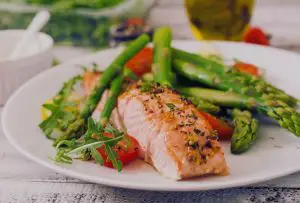Salmon is a popular fish found in many parts of the world. It is often eaten raw or cooked. Salmon can be found in many colors, including pink, orange, yellow, and red.
Do You Eat The Skin On Salmon? Salmon skin is usually considered safe to eat. Its skin can be a good source of omega-3 fatty acids, vitamin D, and vitamin E.
Salmon is an excellent source of protein and other essential nutrients. A 3- to 4-ounce serving has 200 calories, is very low in saturated fat, and is a good source of vitamin B12.
The best vitamin B12 are salmon and fortified foods, like milk and cereal. This fish also contains significant potassium and other nutrients like iron and vitamin D.
Table of Contents
Does Salmon Skin Taste Good?
Salmon skin is a delicious and nutritious addition to your diet. It’s loaded with vitamins A and D and omega-3 fatty acids. If you’re looking for a healthy snack that’ll satisfy your taste buds, give salmon skin a try.
Salmon skin is a delicious and nutritious addition to any dish. The skin contains both Omega-3 fatty acids and protein, making it a valuable source of nutrition. Although some people may find salmon skin a bit bland, the skin provides a lot of flavor and texture to this more mild-tasting fish.
Salmon skin is an excellent source of many vitamins and minerals, including vitamin B and vitamin D, excellent sources of omega-3s, according to the Mayo Clinic. Triglyceride levels and your chances of heart disease are also reduced when salmon skin is eaten.
Salmon skin and scales are a popular food in some parts of the world. They are considered a delicacy, and some people believe that they have health benefits. Here are five reasons why you might want to try eating salmon skin and scales:
- They are high in omega-3 fatty acids.
- They contain vitamin D.
- They are a good source of minerals, including phosphorus, magnesium, selenium, and zinc.
Is Salmon Skin Good For Cholesterol?
Salmon skin is high in omega-3 fatty acids, which are beneficial for cholesterol levels.
A study published in the “Journal of the American College of Cardiology” found that people with high triglyceride levels who ate salmon skin every day for 12 weeks saw reduced triglycerides.
There’s strong evidence that fatty acids found in salmon skin can reduce triglyceride levels. Salmon skin contains EPA and DHA, two types of fatty acids that have been linked with reducing triglyceride levels.
These fatty acids are also suitable for heart health because they help decrease harmful cholesterol levels. Some people also believe that the fatty acids in salmon skin can help to keep the skin elastic and smooth.
Cholesterol is a waxy, fat-like substance found in the blood. It’s essential for the proper functioning of the heart, liver, and other organs. Too much cholesterol can increase your risk for heart disease, stroke, and some types of cancer. The amount of cholesterol in your blood is determined by your genes and diet.
Can You Eat The Gray Skin On Salmon?
You can eat the gray skin-on salmon, but it’s not the most appetizing part of the fish. The gray skin is full of healthy omega-3 fatty acids, vitamin D, and protein. A serving of salmon with its gray skin can provide more than 20% of your daily recommended intake of omega-3s! So don’t be afraid to enjoy this delicious fish skin.
Gray skin on salmon is a sign that the fish is fresh. The gray skin can be eaten, but it is best to remove it before cooking. The gray skin on salmon is made up of melanin, which gives the fish its color. It’s also a good source of calcium and magnesium. If you’re looking to add some healthy nutrients to your diet, give salmon skin a try!
Can You Eat Silver Skin On Salmon?
Silver skin on salmon is a delicacy that many people enjoy. Silverskin is a thin, delicate membrane covering the fish’s flesh.
The silver skin is removed before the fish is cooked. Some people believe that silver skin has a stronger flavor than the flesh beneath it and that it can add a unique texture to the dish. Others enjoy the novelty of eating something unusual.
Can You Eat The Skin On Salmon Fillets?
The skin on salmon fillets is edible and can be a good source of nutrients, but it is essential to clean it thoroughly before eating. The skin can harbor bacteria and other contaminants that can cause illness, so it is vital to make sure it is clean.
You can clean the skin by scrubbing it with a brush and water or using a food-grade disinfectant. Once the skin is clean, you can cook it or eat it raw.
Do You Eat The Skin On Salmon Summary
Salmon skin is a delicious and nutritious part of the fish that is often overlooked. Its skin is packed with omega-3 fatty acids, protein, and other essential nutrients for a healthy diet. Salmon skin is also a good source of antioxidants, which can help protect against certain diseases.
There are a few different ways to prepare salmon skin. It can be eaten raw, smoked, or cooked. Salmon skin is also often used to wrap other foods, such as sushi. Salmon skin is a healthy and delicious part of the fish that should not be overlooked. It is packed with nutrients essential for a healthy diet and is also a good source of antioxidants.
So, next time you are cooking salmon, don’t be afraid to eat the skin.

